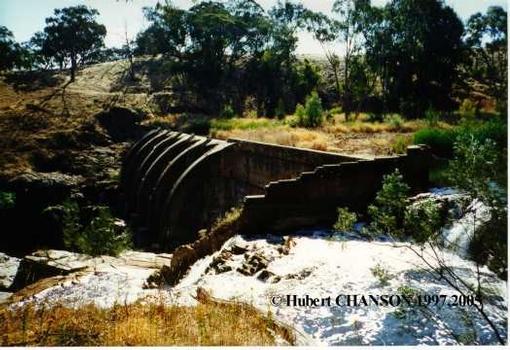General Information
Project Type
| Structure: |
Multiple arch and buttress dam |
|---|---|
| Function / usage: |
Hydroelectric dam / plant |
Awards and Distinctions
| 2017 |
for registered users |
|---|
Location
| Location: |
Lyndhurst, Blayney Shire, New South Wales, Australia |
|---|---|
| Impounds: |
|
| Coordinates: | 33° 37' 9.41" S 148° 59' 47.83" E |
Technical Information
Dimensions
| height | 18.3 m | |
| crest length | 131 m | |
| arches | span lengths | 5 x 8.5 m |
| crest thickness | 0.5 m | |
| base thickness | 1.22 m | |
| number of arches | 5 | |
| radius of curvature | 8.53 m | |
| spillway | spillway capacity | 15 m³/s - 38 m³/s |
| Initial construction | ||
|---|---|---|
| reservoir capacity | 2 467 000 m³ | |
Materials
| foundations |
concrete
|
|---|---|
| arches |
brick
|
| walls |
concrete
|
Chronology
| 1895 | Start of construction. |
|---|---|
| 1897 | Completion. |
| 1902 | Heavy reservoir siltation. |
| 1930s | Desilting of reservoir by explosives. |
| 1985 | Identified as an item of NSW Environmental Heritage by NSW Heritage Council. |
Notes
The dam is located at Junction Reefs, New South Wales, Australia, about 7 km North-West of Lyndhurst. It is located on the Belubula River, 500-m upstream of its confluence with the Mandurma Ponds.
Built to supply hydropower to the mining company. Four Pelton wheels were supplied in water by the reservoir.
Built between 1895 and 1897, completed in 1897, the Junction Reefs dam is a concrete-brick multiple arch dam: it is 18.3-m high with a 131-m long crest. There are 5 elliptical arches, with a 8.5-m span each and a 60-degrees lean, sitting on 6 buttresses. The dam foundation and the outside walls are made of concrete. The arches and buttresses are brick works. The original storage capacity was 2,467,000 m³. The dam was equipped with a large scour outlet system and a pipe inlet to supply the Pelton wheels. The scour tunnel was protected by an earth embankment and a screen system. The main spillway is an unlined rock stepped cascade on the left bank (4 to 8 steps) (Q ~ 38 m³/s) and an emergency overflow is located over the 5 arches (Q ~ 15 m³/s). Original drawings indicate that the spillway cascade was gated (SCHULZE 1897). Today it is ungated. The reservoir was silted considerably during the floods following the Great Drought of 1900-1902. Efforts were made to desilt the reservoir in the 1930s, by inserting explosives in the scour tunnel. They were not completely successful and the reservoir never regained its original capacity. The reservoir is fully silted today.
The Junction Reefs dam was the first multiple-arch dam in Australia. The second one was at Great Lake reservoir (Launceston, New South Wales, 1922). Other Australian multiple-arch structures include Ingleburn dam (Ingleburn, New South Wales, 1934) and Julius dam (Mount Isa, Queensland, 1976) . At Junction Reefs, brick construction was selected as the cheapest and quickest material to build for the arches , concrete being cheaper only for the foundation (SCHULZE 1897). [There was presence of good clay for brick-making near the dam site.] Curiously the original design included 6 arches but the final design had only 5 arches because of delays in the brick-making. The arches were designed in the same way as bridge (or culvert) arches, and the buttresses were calculated as bridge piers. ["The arches were calculated in the same way as bridge [...] and the buttresses as bridge piers" (SCHULZE 1897, p. 171).] Professor C. O'Connor commented that the arch shape and brick laying was unusual: the arch bricks were laid inclined parallel to the upstream arch face, while the buttress elliptical shape was not easily understandable. The Junction Reefs dam is well-known overseas (WEGMANN 1922, SMITH 1971, SCHNITTER 1994).
Participants
Relevant Web Sites
Relevant Publications
- (1922): The Design and Construction of Dams. John Wiley & Sons, New York (USA).
- (2002): Historical Development of Arch Dams. From Cut-Stone Arches to Modern Concrete Designs. In: Australian Civil Engineering Transactions [IEAust], v. 43 ( 2002), pp. 39-56.
- (1998): Historical Development of Arch Dams in Australia. From Advanced Designs to Engineering Failures. Department of Civil Engineering, The University of Queensland, Brisbane (Australia), pp. 133.
- (1994): A History of Dams. The Useful Pyramids. Balkema Publishers, Rotterdam (Netherlands).
- (1971): A History of Dams. The Chaucer Press, Peter Davies, London (United Kingdom).
- About this
data sheet - Structure-ID
20018215 - Published on:
28/10/2005 - Last updated on:
29/07/2014





